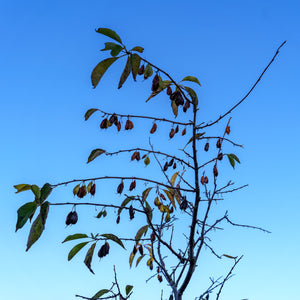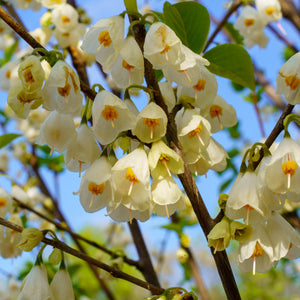The Halesia Guide
Halesia, commonly known as silverbell, is a beautiful deciduous tree treasured for its delicate, bell-shaped spring flowers and graceful form. Native to the southeastern United States, Halesia brings soft elegance to gardens with its pendant white or pink blooms, textured bark, and pleasing green foliage that transitions to soft yellows in fall. Often underutilized, Halesia trees deserve greater attention for their ability to provide four-season interest, particularly in naturalistic and woodland-style landscapes.
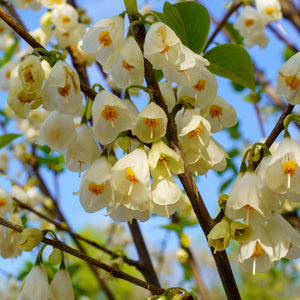
About
The Halesia genus includes several species, with Halesia carolina (Carolina silverbell) being the most widely cultivated. Halesia carolina is a small to medium-sized ornamental tree that typically grows 20 to 40 feet tall, offering a refined, airy canopy ideal for residential gardens. Cultivars like ‘Jersey Belle’ feature larger white flowers and improved vigor, while ‘Wedding Bells’ delivers an abundance of pure white blossoms for a striking springtime display. The variety ‘Rosea’ offers rare pink-toned flowers, adding a soft blush of color.
Halesia diptera var. magniflora, or the two-winged silverbell, is another notable species distinguished by its slightly different fruit structure and broader, often more heavily flowering habit.
Halesia trees are relatively slow growers but reward patient gardeners with a canopy filled with bell-like blooms that seem to hang from the branches like ornaments. Their graceful form, adaptability to partial shade, and resistance to most pests and diseases make them an excellent long-term investment for landscapes seeking a combination of seasonal beauty and ecological value.
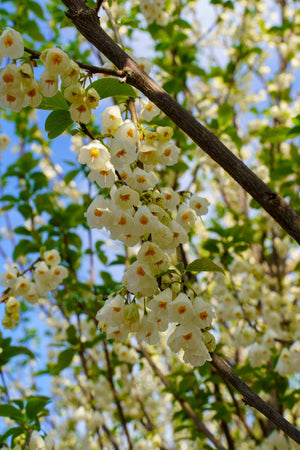
PLANTING
Choosing the right location and planting method helps Halesia establish strong roots and achieve optimal flowering and growth.
USDA Hardiness Zones: Most Halesia varieties thrive in Zones 5–8, with some tolerance for Zone 4 winters and Zone 9 heat in protected sites.
Soil: Prefers moist, well-drained, slightly acidic soils rich in organic matter. Amend alkaline or poor soils with compost to improve structure and pH.
Sunlight: Full sun to partial shade. Halesia blooms most prolifically in full sun, but it tolerates partial shade and often appreciates some afternoon shade in hotter climates.
Watering: Provide consistent moisture, particularly during establishment and in dry periods. Mature trees are somewhat drought-tolerant but perform best with regular watering.
Spacing: Depending on variety and desired effect, space trees 20 to 30 feet apart. Smaller cultivars like ‘Wedding Bells’ can be positioned closer to structures or patios.
Planting Time: Early spring or fall is ideal, giving roots time to establish during mild weather conditions.
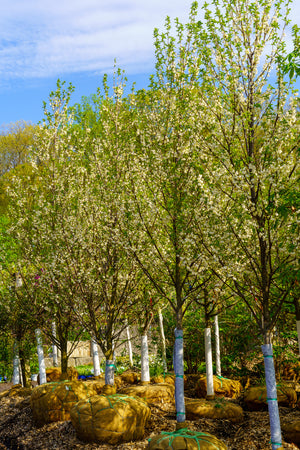
CARE
Halesia is relatively low-maintenance once established, but proper early care ensures a healthy and vigorous tree.
Watering: Water deeply and regularly during the first two years. Mature trees benefit from deep watering during extended dry spells.
Fertilizing: Apply a slow-release, balanced fertilizer formulated for acid-loving plants in early spring if growth appears slow or foliage is pale.
Pruning: Minimal pruning is needed. Prune only to remove dead, damaged, or crossing branches, preferably in late winter before bud break. Light shaping can help maintain an open canopy for better air circulation and flowering.
Pests & Diseases: Halesia has few significant pest or disease problems. Occasional leaf spot or mildew can occur in overly humid, poorly ventilated sites but is rarely serious.
Mulching: A 2–3 inch layer of organic mulch around the base helps retain soil moisture, moderate soil temperature, and suppress weeds. Keep mulch several inches away from the trunk.
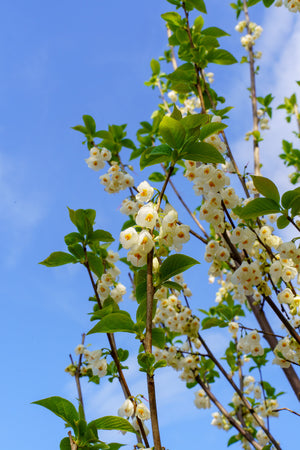
HOW TO USE
Halesia trees provide soft, refined beauty suitable for many landscape styles. Their manageable size, graceful form, and floral impact make them excellent choices for both specimen planting and integrated garden designs.
Focal Point: Halesia carolina ‘Jersey Belle’ and ‘Wedding Bells’ serve as perfect focal points in gardens, drawing attention with their profuse white blooms in spring. Plant near patios, walkways, or garden entrances where their blossoms can be admired up close. Their delicate flowers dangling beneath branches create a unique silhouette against the sky.
Woodland Gardens: Halesia’s natural habitat is the forest understory, making it a perfect choice for woodland or naturalized gardens. It pairs beautifully with native companions like dogwoods, serviceberries, and redbuds. Underplant with shade-tolerant perennials such as ferns or woodland phlox for a layered, natural look.
Foundation and Patio Plantings: Smaller cultivars like ‘Rosea’ and ‘Wedding Bells’ are excellent near homes or patios where their fine texture and seasonal display soften hardscapes without overwhelming the space.
Pollinator Gardens: The spring flowers attract bees and early-season pollinators. Plant alongside other nectar sources like amelanchier, viburnum, and flowering crabapples to support beneficial insects and create a dynamic seasonal transition.
Mixed Borders: Halesia integrates well into mixed borders with larger shrubs and small trees. Combine with azaleas, rhododendrons, hydrangeas, and magnolias to extend the flowering season from spring through summer. Fall companions like oakleaf hydrangea and fothergilla will complement Halesia’s soft yellow autumn foliage.
Slopes and Banks: When planted on slopes or elevated sites, the pendant flowers are displayed even more dramatically against a backdrop of sky or open space, enhancing the visual impact of the tree’s flowering.
Historical and Educational Landscapes: Given its native heritage and ecological benefits, Halesia fits well into restoration projects, native plant gardens, and educational landscapes designed to showcase regional flora.
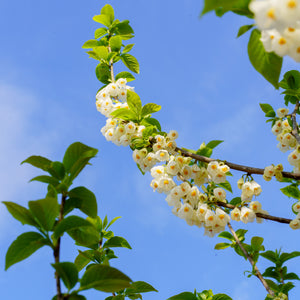
Common Questions
How tall does Halesia grow? Depending on species and cultivar, Halesia trees typically reach 20 to 40 feet tall at maturity, with a spread of 15 to 30 feet. Dwarf selections and cultivated varieties may stay on the smaller end of that range.
Does Halesia need full sun? Halesia performs best with full sun to partial shade. Full sun promotes the heaviest bloom production, but the tree is quite tolerant of light to moderate shade, especially in southern climates.
When does Halesia bloom? Halesia blooms in mid to late spring, usually between April and May depending on the climate. Flowers appear before or as the leaves emerge, creating a delicate and ethereal display.
How big does Halesia get? A mature Halesia typically grows 20 to 40 feet tall with a similar or slightly narrower spread. Cultivars like ‘Wedding Bells’ and ‘Rosea’ may remain on the smaller side, closer to 20 to 25 feet at maturity.
Conclusion
Halesia offers a refined blend of beauty, resilience, and ecological value, making it an excellent choice for a wide variety of landscapes. From its graceful springtime blooms to its soft fall color and textured bark, Halesia provides year-round interest with minimal maintenance. Whether used as a focal point, nestled into a woodland garden, or incorporated into pollinator plantings, Halesia trees bring timeless charm and enduring appeal to the landscape.
The Halesia Collection
Sold Out
Sold Out
Sold Out

